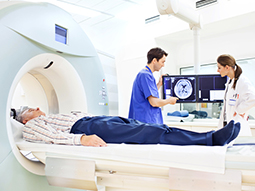What is interventional radiology for arterial disease?

Our interventional radiologists are experts in using minimally invasive techniques and advanced imaging technology to diagnose and treat life-threatening diseases involving arteries.
Interventional radiology is a minimally invasive diagnostic and treatment option for patients experiencing pain or life-threatening conditions in the arteries that supply blood throughout the body. Arterial disease may include the following types of disease:
-
Peripheral Arterial Disease: Hardening of the arteries that leads to severe pain and decreased mobility
-
Arterial Aneurysms: A life-threatening condition when a blood vessel is bulging and weakening or an area where a blood vessel is dilated and larger than normal
Using advanced imaging, such as 3D fusion imaging, X-rays, and computed tomography (CT) scans, interventional radiologists deliver precise treatment through a thin tube called a catheter.
Patients who undergo interventional radiology procedures to repair arterial diseases experience less pain and risk of complications than traditional surgery since most procedures only require a small incision. Most patients will also receive a sedative instead of general anesthesia, allowing them to go home the same day of their procedure.
Interventional radiology for arterial disease treatments
From minimizing painful symptoms by restoring blood flow in blocked arteries to sealing off life-threatening aneurysms, our interventional radiologists work with a variety of specialists to ensure your arteries are functioning properly, including cardiologists, podiatrists, and vascular surgeons.
Learn more about the interventional radiology treatment options for arterial disease offered at MedStar Health below.
Endoleak embolization
If you had an aortic aneurysm repair, you may be at risk for endoleaks, which is the persistent filling of blood in an aneurysm sac. To prevent rupture, a minimally invasive procedure called an endoleak embolization may be performed. Using a catheter guided by 3D fusion imaging, interventional radiologists can block endoleaks and stop blood flow to the aneurysm sac.
Peripheral vascular disease angioplasty and stenting
If you have peripheral vascular disease, angioplasty and stenting can help restore proper blood flow and relieve painful symptoms that prevent you from feeling your best. Our interventional radiologists use minimally invasive techniques so you can resume normal activities within just a few days.
Visceral artery embolization
When a portion of your abdominal arteries that supply the spleen, kidney, liver, and intestines with blood expands, a condition known as a visceral aneurysm may occur. If it continues to grow, an interventional radiologist will treat it using minimally invasive techniques, such as a visceral artery embolization, to block off the blood flow to the aneurysm sac and minimize the risk of rupture.
Our providers

Expert interventional radiology care
Getting the care you need starts with seeing one of our interventional radiologists.









